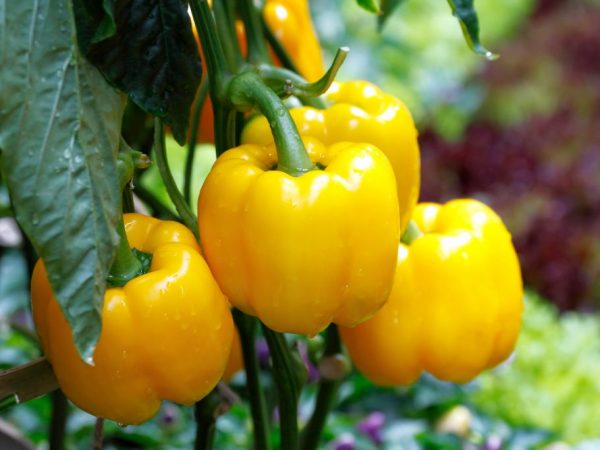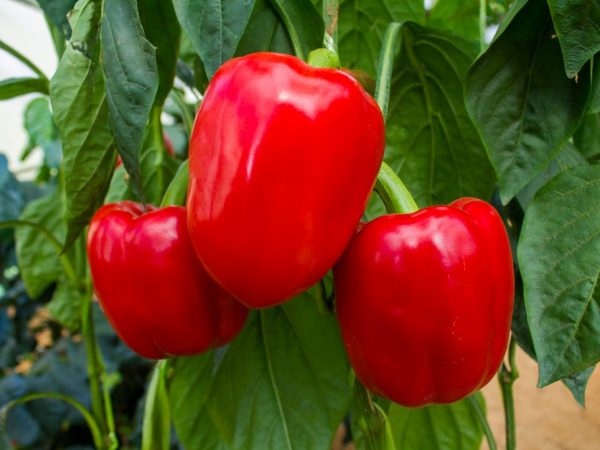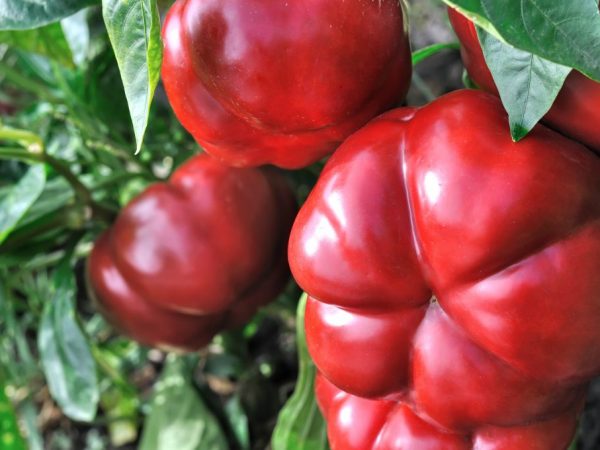What are the best sweet peppers?
Before planting peppers in open ground, it is necessary to study the features of growing a vegetable. For this, the best varieties of sweet peppers are chosen: they grow well without a greenhouse shelter and give large fruits.

Description of the best varieties of sweet peppers
Early varieties of bell peppers
The most unpretentious and persistent types of peppers do well outside the greenhouse. You should not mess with sissy plants: in unprotected soil, their bushes slowly gain plant mass. It is worth paying attention to the varieties of sweet peppers that produce crops in a short time.
An important advantage of early varieties is their resistance to viral infections.
When the bushes grow, they feed them, otherwise the Bulgarian fruits grow medium-sized. A diluted solution of cow dung is used as a top dressing for fruiting plants.
Big Mom
The plant is able to tolerate cool temperatures without stress. In an open area, the bushes grow 50-70 cm in height. The average ripening period of peppers is 100 days.
From 1 sq. m of plantings, the gardener receives 7-8 kg of sweet orange fruits. Fleshy peppers, large. Big Mama is the best stuffing option.
Merchant
This variety was created specifically for growing in cool regions, for example, in the Moscow region. The harvest can be obtained 100 days after planting the seeds. Juicy bright red peppers are shaped like a cone. The fruits tolerate transportation without problems, are stored for a long time and do not deteriorate.
Bushes of the Kupets variety grow more amicably and bring the best harvest if bred with seedlings in a house or apartment. It is advisable to plant seedlings in the garden if warm spring weather is established outside. In an open area, seed germination is low.
Mid-season varieties of bell peppers
Mid-season crops bear fruit for a long time. You can get sweet peppers from a bush in moderate temperatures 130-140 days after the sprouts appear.
The best mid-season sweet peppers are pest-resistant.
Swallow
Seed germination of the Swallow variety is excellent. Bushes need to be tied up, because they are quite tall. The vegetable culture is resistant to disease. The plant feels comfortable in unprotected soil. The fruits are cone-shaped.
The color of unripe fruits is light green, the color of ripe fruits is red. Fruit weight - about 100 g.
Atlant
From the day the first shoots appear until the harvest, 140 days pass. The shape of the bush is standard. For 1 sq. m accounts for 4 kg of fruit. This pepper variety yields a bountiful harvest if the seedlings are started at the end of February.
The grown seedlings planted in open ground are not watered abundantly, but the plant does not like drying out either. Red peppers are dense and juicy.
Late-ripening varieties of bell peppers

Bell peppers are good for salads
The special value of the seeds of late varieties is that you can feast on the fruits until mid-October.
Hercules
A hardy variety with a significant growing season, so the seedlings are prepared in advance. The beginning of March is the deadline for sowing seedlings. Bushes are low, spreading. The leaves are dark green, slightly wrinkled.
A summer resident can harvest from the bushes after 130 days. Juicy, aromatic vegetables are cube-shaped. The deep red color indicates their ripeness. Fruits are good in salads, suitable for preservation.
Yellow bell
To grow peppers in the open air, seedlings are planted in the ground at the end of May, and sown in March.
There is little foliage on the Yellow Bell bushes. The variety is resistant to tobacco mosaic virus and temperature extremes. Ripe fruits are yellow. The full ripening of the peppers occurs at 150-160 days. They are used for salads, vegetable stews.
Bogatyr
Bogatyr is a sweet late-ripening variety. Powerful spreading bush is undemanding to watering. The variety is resistant to top rot, tobacco mosaic. From the day of planting the seeds to ripeness, 4 months pass.
Benefits of culture:
- good growth in unprotected ground;
- the ability of the culture to withstand thickening;
- impressive fruit weight (160 g);
- yield: from 1 sq. m collect 6-7 kg of fruits;
- the quality of the peppers does not decrease during transportation.
Marshmallow
Zephyr is one of the most interesting varieties of bell peppers. The bushes of the plant are spreading, strong. You don't have to tie them up. The dark green pepper looks like a ball. When fully ripe, the fruit turns red. Its average weight is 160 g. The pulp is tasty and aromatic. The Zephyr variety feels comfortable under a film cover.
Hybrids

Hybrid varieties will delight you with large fruits
Hybrids are resistant to plant diseases and large fruits. Hybrid seeds are not suitable for the next planting.
Marinkin tongue
Maryin's tongue is an option for lovers of massive peppers. The plant tolerates unstable weather conditions. The bush must be tied up, because from the severity of the crop, it can fall.
The shape of the peppers resembles a tongue. They are dark cherry colored. The fruits have a pleasant sweet taste and juiciness.
Triton
This hybrid is resistant to cold weather, dampness, wind. When planting seedlings in the ground, the first ovary on the bushes is removed. This condition is necessary for the bush to develop well.
45-50 fruits are removed from one bush. At the stage of technical ripeness, the fruits are yellow. They turn red when they are fully ripe.
Atlantic
The largest fruits are produced by the Atlantic variety. Seedlings are planted in mid-March. The seeds are wrapped in a damp cloth and kept for two days to ensure good germination.
In the last days of May, seedlings can be planted in the beds. The bush is tall and strong. The distance between two bushes should not be less than 40 cm. The fruits are massive, juicy, ripen 3 months after the first green shoots appear. The pulp is tasty, aromatic.
Thick-walled large-fruited varieties
Consider the best thick-walled sweet peppers.
White gold
This early variety became famous for its very large fruits. It is better to start preparing seedlings in February. The plant needs frequent watering. Bushes are strong, with bright green leaves.
The plant needs to be fed, but fertilizers cannot be overused. The weight of the peppers ranges from 270 to 450 g. The golden color and pleasant taste of the fruit make the variety irreplaceable. It is often grown for sale.
Siberian format
Sowing for seedlings is recommended to be done 2 months before planting the pepper in a permanent place. On fertile soils, the bushes quickly gain plant mass and form fleshy fruits.
Fruit weight - 400 g. Wall thickness is 10 mm. At least 10 peppers are harvested from one bush. The taste and smell of the pulp is delicate.
Watering plants with rainwater increases the chances of a large harvest.
Queen
A hybrid variety of a vegetable. The variety is unpretentious in care.The plant tolerates coolness normally, is not afraid of pests. The bush must be tied up so that the branches do not break from the severity of the harvest.
The peppers become ripe 105-107 days after the first shoots appear. The wall thickness of the sweet fruit is 12 mm. The pulp is juicy, aromatic. Vegetables are suitable for canning, stewing, stuffing.
Conclusion
Many varieties thrive without a film coating. You should purchase planting material based on your goals and taste preferences. The ripening time and taste of the fruit differ for each variety.
Those wishing to grow peppers for salads should pay attention to the early varieties. Connoisseurs of bright taste and aroma opt for mid-season crops. Hybrids are also good. They are resistant to temperature extremes and give a generous harvest.
In order for the seeds of your favorite varieties to sprout well, you can hold them in aloe juice before planting. Shop-based germination stimulants "Epin", "Novosil" also give good results.


